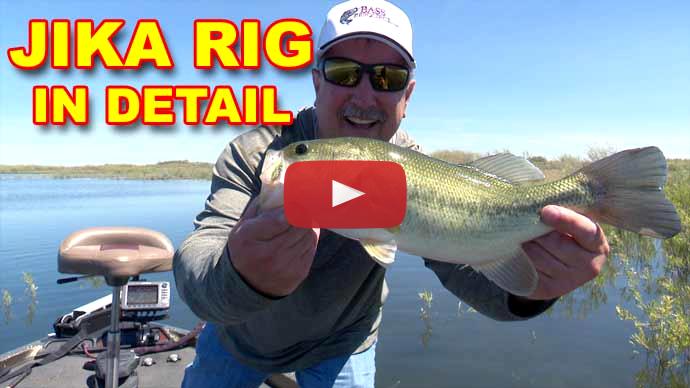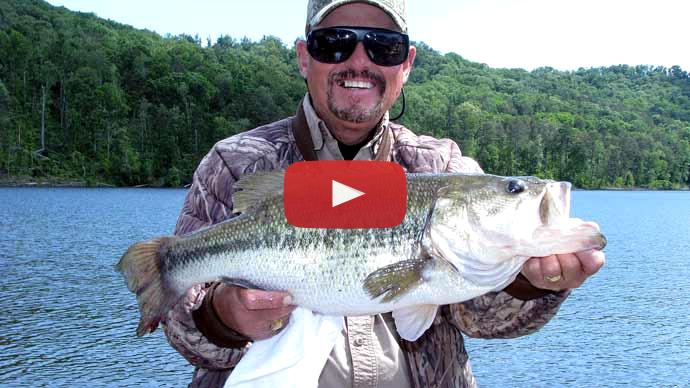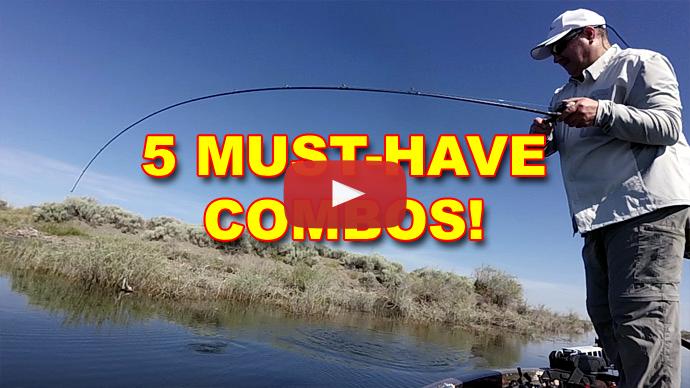Glenn: There we go. Come out of that bush. Here we go. Free Rig strikes again. There we go. Nice. There we go.
Hey folks, Glenn May here with BassResource.com and today let's talk about the Free Rig. Yeah, the Free Rig. This is really cool. It's something that's been around for a while. It's come from Asia. Actually, it started I believe in Korea, made its way over to Japan where fishing pressure is really high there. These bass see the same presentation over and over again, the same baits over and over again, so the Japanese they need to come up with new and innovative ways to present lures to bass that is going to entice them to bite. And the Free Rig has come out as one of the front runners. It's actually a really good way of catching fish more than just under pressure conditions, but just like when you're in a tournament or something like that and you want to get the fish something a little bit different. It really works well. I've been playing with it for a while now and I've really enjoyed it. I like throwing it.
So let me talk to you a little bit about what that rig is, what it looks like, and how it works. Let's talk about some of the components and how to rig it, including the line, the reels to use, that sort of thing, and then I'm going to talk about how to fish it and show you guys how to do it. There's a learning curve here, and I want to help you flatten that curve a bit so you can get to fishing and catch more fish.
So let's dive right in to what is the Free Rig? Well, basically, it's just a hook at the end of the line and above that is a weight that slides up and down the line. It's this. All right. This is the Free Rig. And as you can see, the line....or sorry, the bait goes up and down the line freely. That's part of the reason why it's called the Free Rig, but also the bait here on the back, it can move around easily, it can spiral downwards, it can dart and dive, lift up and down. It can move around freely, so hence the term Free Rig, free-moving bait, free-moving weight. Okay.
Now it can be any hook. In this case, I'm just throwing a 3/0 EWG hook here, Gamakatsu, and on it I've got a Rage Bug, but you can use...this is what's so beautiful about it is you can use any kind of hook, any size hook, any kind of bait. I don't know if I would use a stick bait with it because a stick bait already free falls and it's got its own natural presentation. I'm not sure if it works so well with this. I haven't tried it yet with this, but I've tried lizards, I've tried, obviously, Rage Bugs, I've tried worms, I've tried a couple of different other plastic baits that are out there and they all seem to work really well with it because what happens is when you cast the weight out, the weight slides down the line as it's sinking because it's going through the water column and this slides down. And when it hits the bottom, then this bait slowly comes down on its own.
What's really cool about this is the bait, at first, it's coming down the water column really fast, and then when it hits the bottom, it stops and changes speed, and also changes direction, and the way that it falls. It starts to do that spiral move, or darting, or swaying side to side. So it's going down quick and it stops, and then it does kind of this, right? That's something the bass haven't seen, make a lure change direction and speed. So that's often where you get bit as the bass will chase it, follow it down, not really willing to bite it, and then suddenly bang, it stops and changes direction, boom, triggers a bite.
Wowee. We are mad. We are mad, mad, mad. There we go. That's a good one. Stuck him good. Boy. He got a nice little belly on him. Feeding good. I'll take it. This is so much fun. Here you go. I'll let you go, buddy. Thank you.
So how do we rig this thing anyway? Well, as you can see this bait here...sorry, this weight, it kind of looks like a drop shot weight, right? It kinda does. Well, yeah, it's not. Let me show you here. Let me show the difference with this thing.
What you have here...so it's a cylinder weight, yes but can you see that? There's a little loop there and a loop at the top. And that loop is where the line goes through. Now you might think, "Well, I can use a drop shot weight, right?" Well, I have a drop shot weight right here, a little teardrop drop shot weight. Notice the line tie is different up here. It's more of a clip. And that line tie is designed for the line to slide up in that little tight part on the top and hold the weight in place, which is the opposite of what you want with the Free Rig. You want the Free Rig...you want this weight to slide up and down the line. So, you know...And it's got a little swivel here. I know you can't see me spin, but maybe you can see that and I can spin this around, so it moves around freely. That's really critical because it enables it to slide up and down and it doesn't get hung up as much.
Now you might be thinking, "Okay, why don't I just use a casting weight, right? It's got a loop at the top and that should work, right?" Well, let me save you some time here. I actually tried it with a casting rig because I thought the same thing.
The casting weight is more of a round-shaped weight. And I found that it gets hung up a lot and it's picking up a lot of junk off the bottom, a lot of moss, algae, it picks up weeds. So I was spending a lot of time picking that off rather than casting. And if I throw it around riprap, rocks, and things, I was getting hung up a lot more.
So I was spending more time unhooking it, getting it unsnagged, cleaning off weeds. And at the end of the day, that equates to a lot of casts that you just didn't make, which could mean less fish. So it's just not a very effective way to fish it. You can use a casting weight if you want. I'm not telling you not to, but, you know, you have a lot less trouble and worries with the cylinder weight.
Now, it took a little work for me to find a cylinder weight. I started fishing these a couple of years ago, and to find the right kind of weight. So I'll just put a link down here at the bottom of the video, make it easy for you guys so you can get to it, and find it, and see if you guys want to pick up some of those for yourself. But that's the key to fishin' this is having the right weight. It goes through the cover really well, it doesn't pick up junk, and it doesn't get hung up in the riprap.
So that's basically how you rig it. Now, it depends on where you're throwing it as to what kind of line, and rod, and reel you're using. I like to throw it around cover, or next two cover, or next to weed lines, or throw it into weeds. So I'm using a little bit sturdier equipment there.
Here I'm using a fluorocarbon line. I'll use either say InvizX 15-pound fluorocarbon line. That's kind of a general-purpose all-around line. You can throw that around rocks, weeds, sticks, all that kind of stuff.
I don't throw braid in this instance because braid doesn't hold up as well in rocks as fluorocarbon does. Braid actually can get nicks, and frays, and beat up easier than fluorocarbon. And I like the versatility of this bait of this whole rig. You can throw it anywhere you want to. And I want to be ready to throw it wherever I want to and not be worried about my line getting frayed or nicked, so I'm throwing 15-pound InvizX.
If it gets really thick cover, heavier stuff, then I might up that a little bit and maybe use 17-pound AbrazX. That's a stronger line, but for all-around all-purpose, throwing it anywhere, it'd be the 15-pound InvizX.
With that, I'd be using an all-purpose rod, 7-foot-1, 7-foot-4 medium heavy, fast action tip rod. Paired with it, the reel. This isn't a bait that you move really fast, so you don't need a high-speed gear ratio. So you can get away with a 6.1 to 1 gear ratio up to maybe a 7.1 to 1 gear ratio. Anywhere in that range, you'll be just fine.
Now you can also use it for finesse tactics, right? So you can lighten up, use a much lighter weight, something in that, you know, 1/8 ounce range, maybe 1/32, something like that, and use 6-pound fluorocarbon line with a medium-power rod fast action tip using a size 2,000 or 2,500 reel.
Notice I didn't say anything about leader. No. Don't want to use leader in this instance. The knots are going to get in the way of this weight sliding up and down the line. It'll get hung up on the knot. So this is not a rig that you use leaders with. I know one friend of mine put like 60 feet of leader on there, but it's like that defeats the purpose. That doesn't make any sense. So just use straight line. Straight fluorocarbon's fine, or you can use copolymer line as well. There's nothing wrong with that. Again, 15-pound copolymer works just fine, but don't use leader because you're going to inhibit the action of this bait and the bait behind this. That inhibits the action of the weight and the bait. Boy, say that 10 times fast. All right, so that's kind of how you rig it. Let's talk about how you fish it.
There we go. There we go. Gotcha. Gotcha. Fell victim to the Free Rig. This is so much fun. Thank you, buddy. Let you go.
So the key with fishin' this bait and this rig is the weight falling down, hitting the bottom, and then letting the bait flutter down on its own until it hits the bottom. And this is a hard thing to do because the weight obviously is going to fall faster than the bait. And because we're so used to...us, bass fishermen, are so used to throwin' Texas rigs and jigs. After something hits the bottom we're used to picking it up and start working it, right?
That defeats the purpose. You need the wait. Once the weight hits the bottom, stop, don't move anything, wait because now you're waiting for that lure to make it to the bottom.
And this is where it gets real tricky, guys. Depending on how deep you're throwing, it's how far the weight has slid down the line so you have a variable length of leader, basically, between the weight and the lure. And so the deeper you throw, the longer it's going to take for that bait to flutter down to the bottom.
Plus another variable is different baits fall at different rates. And some of them zigzag and spiral down, other ones come straight down, other ones take a long time to flutter. A bigger bait takes longer like a big Rage Hawg. It takes longer to flutter down.
So what you should do, this is what I suggest you do, is find some clear water, either in a lake or river where you fish, or maybe you've got a swimming pool, and play around with different baits, and get an idea of how long it takes them to fall and what kind of action you get out of them so you have an idea of what the fish may want that day.
Some fish want something that does spiral or kind of zigzags and darts on its way down. Other times they want something that just kind of slowly sinks and falls kind of straight down. They want different actions. So understand how your different baits fall weightless and the speeds they have will give you an idea of how long to wait once that weight hits the bottom and you got to wait for that lure to make its way and hit the bottom.
That's the key to fishin' this thing and what makes it so difficult, but also so enticing and so good. So play around with that. I did, and it took me a while.
Another thing to consider is when you're throwing it out there in deeper water, say deeper than 5 feet, you do have all this line out there, you know, especially between the weight and the bait. And when a fish bites it, he doesn't feel any weight. Anything unnatural he's not biting on a Texas rig where there's a weight right there, he doesn't feel any resistance from the line, so they hold onto it longer, which is great. But you've got to remember there's a lot of line out there and reel up that slack line before you set the hook. Don't make the mistake I made.
So I forgot about that. And, you know, I'm going to show you this clip. And this is exactly what happened to me. I was throwing it out about 8 feet of water, and the weight hit the bottom, and the fish hit it while the bait was falling, and I forgot to reel up all that slack. And when I set the hook, you're going to notice a couple of things.
First of all, you're going to hear that line singing through the water. It almost sounds like my reel slipped. Matter of fact, you hear my wife mention that. She'd made it sound like my drag slipped. She thought for sure my drag was too light. I assure you guys, my drag was cinched down really tight. And what you hear is that line being picked up when I set the hook.
The other thing you notice is when I set the hook, look how far back I bring that rod. Half of that hook set was just bringing up the line, so I didn't really connect with the fish 'till I was already far back. So I had to go back even further to get a decent hook set. Even then, well, I almost didn't get that fish. Here, watch this clip.
Keri: There. There must be something on the bottom.
Glenn: There we go.
Keri: Oh, there you go. Oh, the slide of a hook job though, or a hook set I should say. It slid pretty good.
Glenn: All right. Come here, buddy. Come on. Come here. Give me your face. Here we go. Ooh, just had him by the skin.
Keri: Yeah, you're...
Glenn: There we go.
Keri: When you set the hook, it just like pulled line.
Glenn: Not a huge guy, but Free Rig. That does the trick. I love it. All right, buddy. I'll let you go. Off he goes.
Okay, so you notice that, right? You saw the line I had to pick up. I barely caught the fish. Notice what I said. That fish was barely hooked. So I was fortunate to get that fish in, but, you know, learn from my mistakes, pay attention to how deep you're throwing, and know that the deeper you throw it, the more line you're going to have to pick up that slack before you set the hook and you'll have better hookups.
The beauty about this setup is that you do have this hook that's just out there all by itself. There's no weight in front like a jig head or anything like that in the way that's impeding the hook set. So you really do get good hook sets. And I'm sure that I would not have caught that fish hadn't been a rig like this with such a poor hook set like that. But that's the key things about fishing this setup.
So, guys, if you like what you're seeing, you like this video, please hit the subscribe button and be sure to hit the little bell symbol, because if you do that, then I will send you a note and let you know right when a new video is posted. You'll be the first to see it before anybody else. So hit that subscribe and that bell icon. And like I always say, for more tips and tricks visit BassResource.com.



